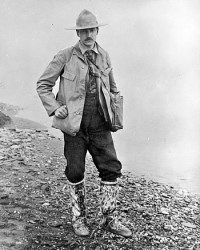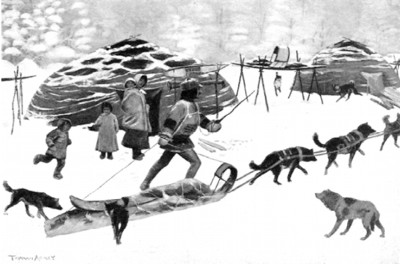|
Home
The Chiefs
The Isaac Family
Family Stories
Newspaper Articles
Photo Album
Yukon History
Traditional Territory
Culture and Religion
Language
Books and Reference
|
Historical Accounts
Interview with Charlie Isaac by Jim Robb
Jim Robb
interviewed Charlie Isaac, son of Chief Isaac of the Tr’ondëk Hwëch’in on
April 13, 1970. The interview contains a discussion of family history and the
cultural effects of the Klondike Gold Rush. Charlie Isaac also sings a
traditional Crow song from Coffee Creek. Mussi cho
Jim Robb. Thank you for this interview. You have done so much for
Yukon and Indigenous Heritage.
Yukon Archives Reference: SR 6 (1) (88/53R)
The recording
has been posted on this website with the permission of Jim Robb. Any use must
have the permission of Jim Robb.
Tappen Adney
|

Tappen Adney
|
Tappan Adney was in the Klondike from 1897 to
1898 to report on the Klondike Gold Rush. In addition to authoring the book
The Klondike Stampede, which is still available in bookstore, he has
provided the following to invaluable articles that include amazing
illustrations:
“Moose Hunting with the Tro-Chu-Tin”, Harper’s New Monthly Magazine,
Vol. C, No. DXCVIII, March, 1900. Read it here.
“Indian Hunter of the
Far Northwest on the Trail to the Klondike”, Outing Vol. XXXIX, No.
06, March 1902. Read it here.
Adney was interested in native cultures before his trip to
the Klondike and probably knew more about eastern natives than any other
white man of his time. He is also well known for his work with birch bark
canoes of which he has constructed over 150 models.
|
Description of Chief
Isaac
Source: Han Hwechin
People of the River, C Mishler and W.E. SimeoneTappan
Adney, who camped and hunted with the Han Chief
Isaac along the Klondike River during the gold rush, described his
personality and behavior. Adney was a splendid
artist as well as a fine writer. His many sketches of Isaac and his people
give us a good sense not only of Isaac the man but also of the nomadic Han
life in the Yukon backcountry. In his article 'Moose Hunting with the Tro-chu-tin," Adney reported that Isaac was a tall man who carried
himself "with conscious self-respect" and had "a flashing eye
that gave the impression both of mastery and shrewdness." Isaac would
get up before daylight, step outside, and announce the day's activities. As Adney described: "He spoke not in the smooth,
melodious tongue of the Eastern Indians, but slowly and deliberately, in
short, crisp, incisive monosyllables. When he was done, he informed me in
broken English that we were to hunt on the left-hand side of the river."
From this description, it becomes clear that it was the chief's duty to give
directions to the people for hunting and traveling. Undoubtedly, the chief's
announcement also served as a general wakeup call. The fact that all the
others were still in their tents at that hour of the morning pretty well
precluded any questions or complaints. At the same time, Isaac is not
remembered for being a bully, but for always talking politely to his
followers.
Although most of the time he spoke Han, Isaac attempted to learn English as
well, and his flavored speech of "short, crisp, incisive
mono-syllables" evolved into a distinctive vernacular: "Mull moose,
too much tupp; cow moose, plenty fat stop, he all
right" meant that bull moose meat was too tough but cow moose meat was
fat and tender. In Han and other Athabaskan languages there is no distinction
between female and male pronouns, so it is common to hear Han speakers use
"he" in place of "she" and vice-versa when they speak
English.
Captain Ferdinand Schmitter Account
of the Chief
Source: ??????
Captain Ferdinand Schmitter of the Medical Corps who,during his term of duty at
Fort Egbert, adjacent to Eagle had this to say about Chief Isaac. (Schmitter 1910) "Under their form of government the
chief (ha-kkih) had despotic authority. He detailed
hunting parties and dictated their duties, and when game was brought into
camp he assumed charge of it, apportioning it out to whom
he pleased. The chief of the Moosehide Indians near
Dawson shows much of the pristine dignity and authority of his rank, and
whenever he buys anything in Dawson he does not carry it home, but sends an
Indian after it. He shows his genteel extraction by always wearing a pair of
fancy decorated gauntlets when he goes on a several days' visit to Eagle
during warm weather."
Tappan Adney's Description of a
Traditional Camp
Source: The
Han Indians-Cornelius Osgood
Tappan
Adney's experience in January 1898 provides an
excellent description of the portable skin dwelling used by the Klondike band
of the Han.
Two
miles from the Yukon, above the mouth of the Bonanza Creek, the head of the
caravan stopped, and Isaac marked the place for the camp at the edge of the
river, alongside a dense grove of spruce-trees. As we turned off the smooth
miner's trail every person old enough to walk slipped into snow-shoes, as the
snow was about two feet deep.
The
women took long-handled wooden shovels and removed the snow off the ground an
elliptical space eighteen feet long by twelve feet wide, banking it all
around two feet high. While some covered the exposed river gravel with green
spruce boughs and kindled a fire in the centre, others cut sticks three to
five feet long and set them upright a foot apart in the bank of snow, the
long way of the intended house, leaving an opening at one side two feet wide
for the door.

Traditional Camp
Source: The Indian Hunter of
the Far Northwest - On the Trail to the Klondike
Tappan Adney, OUTING, Vol. XXXIX, No.6, March, 1902
The house-poles, an inch
thick and ten or twelve feet long, whittled out of spruce and previously bent
and seasoned into the form of a curve, were then set up in the snow at the
ends of the camp to the number of sixteen or twenty, their upper ens pointing toward the middle in the form of a dome ten
feet high. These were strengthened by two arched cross-poles underneath, the
ends of which were lashed to the side-stakes with withes of willow twigs
thawed out and made pliant over the fire. Over this comparatively stiff
frame-work next was drawn a covering of caribou-skin, tanned with the hair
on, made in two sections, and shaped and sewed together to fit the dome. The
two sections, comprising forty skins, completely covered the house, except in
the middle, where a large hole was left for the smoke to escape, and at the
doorway, over which hung a piece of blanket.
The
toboggans with the balance of the loads were hoisted upon pole scaffolds each
side of the house, out of reach of the dogs, who looked and acted as if ready
to devour anything from a moccasin to a rawhide toboggan-lashing.
Not
until the house was done and enough wood stacked before the door to last
until morning did any one stop for a moment. In a climate where the
temperature remains not higher than thirty degrees below zero, and
occasionally drops to fifty or sixty below, it is dangerous to dally, as
white men are prone to do under the same conditions. In our
little village there were seven lodges. In the chief's house were nine
persons and seven dogs, divided into two households, each having a side of
the fire to itself. On ours were Isaac, his wife Eliza, with a nursing boy
less than a year old, myself, and three native dogs--Chicken (child), Gagul (broken leg), and John: also a tawny "whiteman's dog," Beaber,
taken to board, a small black native pup, and an extremely miserable
short-haired white man's pup, wrapped in a blanket to keep from freezing, and
weighing just fourteen pounds by Isaac's spring scale. On the other side were
a middle aged, stocky built man known as "Billy", or "the
missionary's man," and his wife, with two girls respectively about eight
and ten years of age, and a boy of the same uncertain age, four large native
dogs and two pups. The human occupants kneeled or reclined before the fire,
which was ingeniously built to throw the heat in two directions and to draw
well, notwithstanding which latter, I soon discovered that it was often
necessary to lie close to the ground, and when the smoke became too thick, to
lift the lower edge of the skin covering.The
following morning before daybreak word was given "All go."
Toboggans were rattled off of caches, and house taken down and loaded as
swiftly as they had been set up.
|
|
Website
Top Banner
Left to right, back row: Chief Isaac, Fred Isaac, child Edward Isaac. Front
row: Eliza Isaac, Angela Isaac, Charlie Isaac, Princess Pat. Dawson slide
in background. Chief Isaac's drum resembles the slide's shape of a moose.
The Klondike enters the Yukon River at Dawson.
|
|


